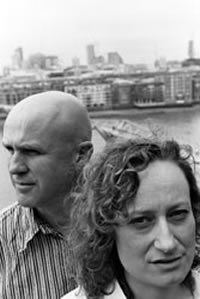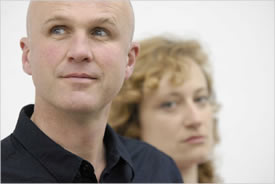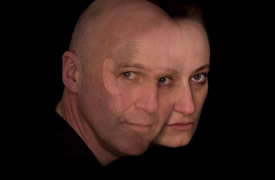
The Looking Glass
By Caridad Svich
England
By Tim Crouch
Chelsea Art Museum
(closed)
"Look," the man says. "Look," the woman
says. Their voices echo one another in the clean, white spaces
of the Chelsea Art Museum galleries. The man (Tim Crouch) and
the woman (Hannah Ringham) are our looking-glass guides into a
journey through a broken love affair, a devastating illness, and
a life-altering organ transplant that traverses London, Atlanta,
the Netherlands and an un-named country in the Middle East. The
play is England, written by Tim Crouch and presented
as part of the Under the Radar Festival.
England is a clear-eyed dissection of the
transient, metaphorical, complex relationships forged between
host bodies and guest bodies -- art and commerce, love and loss,
and First World and Third World countries and languages. First
performed at The Fruitmarket Gallery in Edinburgh in August 2007,
it is a two-hander comprised of two slender acts that run for
an hour without an interval. (There is a very short "breather,"
though, as audience moves from one location in the gallery to
another.) In the first half, Crouch and Ringham (of the British
troupe Shunt) act as lively faux-docents leading us through an
exhibition of heartbreak.
The current exhibition at the Chelsea Art
Museum is "From Non-Conformism to Feminism: Russian Women Artists
from the Kolodzei Art Foundation." Crouch and Ringham move among
the audience seated there, exchanging voices as if within a single
monologue that charts the relationship between a London woman
and her Danish-American boyfriend, both nameless, over the course
of a year when the woman is diagnosed with a severe heart problem.
She will die if she does not receive a transplant. The couple
is presented as upwardly mobile, relatively comfortable and fairly
bourgeois. The boyfriend is an art dealer, and speculations and
reflections on art pepper the opening half-hour as the monologue
moves in and out of different states of consciousness and considerations
of states of joy, ecstasy and suffering.
Are we listening to the musings of the
woman while she is in a possible (inferred but not directly revealed
in the text) coma in the hospital, thinking back on her life in
London and its intimate, quotidian and cherished moments? Or are
we witness to an exteriorization of the internal dialectics of
a couple -- in a One that is really Two? (In the second act, One
figuratively embodies Two, after the woman has received a heart
transplanted from a Muslim man.) Crouch keeps the guessing game
alive in the first act as the slippery but precise strands of
narrative fold into and around each other, braced by the echoing
refrains shared by the couple: "Look. Look." Indeed, again and
again, the piece demands of its audience-witnesses, in a genial
but provocative manner: "Look at this story. Look at how it is
told. Look at the space we're in together. What do we look at
when we look?"
Bert States in Great Reckonings in
Little Rooms (1985) states: "In the theater, image and object,
pretense and pretender, sign-vehicle and content, draw unusually
close. Or as Peter Handke put it, in the theater light is brightness
pretending to be other brightness, a chair is a chair pretending
to be another chair." In England, the gallery at the
Chelsea Art Museum is a gallery pretending to be another gallery:
the gallery of someone's mind and body. The arteries of feeling
that rush through the compact piece are full. The muscles of its
contours are taut. The piece is extraordinarily moving, and yet
Crouch does not beg for empathy. His approach, as in his previous
pieces My Arm and An Oak Tree, is warily warm,
open but distant. His manner is self-effacing and the language
of his work is direct and on the surface, deceptively simple,
but the layers of narrative strands he orchestrates on the page
and in performance are rigorous, complicated, and cut as hard
as a diamond. England, which is co-directed by Karl James
and a smith (written that way), radiates refracted light that
comes at us through the opaque face of a self blown apart by illness
and loss, and in the second half by a self unknown to itself.
 As
the audience sits down in folding chairs facing a white wall in
a lower-level space of the museum, the play's second half presents
the supposedly recovered woman gone halfway across the world to
meet the wife of the dead man whose heart she now carries. The
English woman (enacted by Crouch) is alone with an interpreter
(played by Ringham). The Muslim woman is unseen and her language
is unknown and heard only in translation. The art-dealer boyfriend
is barely mentioned, but it becomes clear through sly hints in
the narrative that the relationship with him has failed. Illness
and perhaps the transplant itself caused an irreparable rift.
The English woman was left with an art piece they both loved:
a DeKooning print, perhaps, although it may also be one of the
other pieces named in the first half of the piece as part of their
jointly held "unofficial" collection. In any case, what we see--and
what we look at in our mind's eye--is a woman who has traveled
at great cost to an unknown city to meet a person from whom she
desires spiritual solace. In effect, the woman believes that if
this other person were to look at her ("Look. Look.") then perhaps
a bond of healing and resolution could be forged. They could understand
each other and perhaps even exchange gifts.
As
the audience sits down in folding chairs facing a white wall in
a lower-level space of the museum, the play's second half presents
the supposedly recovered woman gone halfway across the world to
meet the wife of the dead man whose heart she now carries. The
English woman (enacted by Crouch) is alone with an interpreter
(played by Ringham). The Muslim woman is unseen and her language
is unknown and heard only in translation. The art-dealer boyfriend
is barely mentioned, but it becomes clear through sly hints in
the narrative that the relationship with him has failed. Illness
and perhaps the transplant itself caused an irreparable rift.
The English woman was left with an art piece they both loved:
a DeKooning print, perhaps, although it may also be one of the
other pieces named in the first half of the piece as part of their
jointly held "unofficial" collection. In any case, what we see--and
what we look at in our mind's eye--is a woman who has traveled
at great cost to an unknown city to meet a person from whom she
desires spiritual solace. In effect, the woman believes that if
this other person were to look at her ("Look. Look.") then perhaps
a bond of healing and resolution could be forged. They could understand
each other and perhaps even exchange gifts.
But the transaction that the English woman
seeks is unfulfilled. For the Muslim woman cannot look at her
and see her. She sees only the damage done to her husband, who
was "murdered" by a system that valued his organs more than his
life. As language falters and fails, as translation proves inadequate,
the two women are left inside an unanswered question. "Look."
But what do we see? And moreover, what can we see in
a mediatized world where images of Others are filtered through
veils of difference that hinder true understanding and communication?
Inside a lexicon of failure--failed utterances,
failed bodies, failed and foiled transactions, collapsing words,
and wounded hearts--England questions how a colonizing
body wrests the objectivity of narrative from a subjected Other.
The English woman in the first half leads a quiet, unassuming
life of privilege. The DeKooning print matters to her and her
boyfriend because it's beautiful, yes, but moreover because of
what it's worth and what it will be worth over time. The value
of art and the value of life are intertwined as the woman tries
to find meaning in the spiritual gifts that art can offer, but
the society in which she lives offers little space for that meaning
to be revealed.
The co-directors (who also co-directed
Crouch's An Oak Tree) have crafted a singular performance
experience with this site-responsive play for galleries. While
the published text includes references to The Fruitmarket Gallery
where the piece originally premiered, it is clear that each performance
must take into account the history, architecture and sonic reverberations
of the new site where it plays. There are open spaces in the published
text for such insertions and reconsiderations. The spectator is
central to the way the piece operates as theater. Crouch and Ringham
are at first interspersed casually among the standing audience
that awaits the piece's beginning. They speak from the crowd and
refer to whatever physical obstructions are in the space as they
welcome the audience to the piece. They are tour guides of sorts
to a tour that has no clear destination. The piece moves from
this genial prologue into four discreet movements where the performers
play alongside pieces currently in the exhibition (in this case
artworks and photographs in the "From Non-Conformism to Feminism"
exhibit) and the audience is surrounded by the art. The spectator
is guided gently but the signs of each movement aren't necessarily
obvious.
Each movement corresponds to a shift in
the audience's perspective. There are marked silences in each,
and also an undulating, rippling, sound-scape (designed by Dan
Jones) that emanates mysteriously from the performance space --
at turns ambient and minimal and at others threateningly loud
and ominous. Although Crouch and Ringham are highly skilled, inviting
and compelling performers and act well as "hosts" to the "guest"
bodies of the story -- the spectators -- the narrative is often
quite internalized and thus unsuited to the usual performance
circumstance. This is not an event happening before you, although
it seems to be, because it is a play, after all, but rather an
explication of an event that is past. We as audience are witness
to an aftermath of someone else's experience, and we're left to
wrestle with the varying encounters we've had with it.
 Crouch
plays both the boyfriend and the girlfriend at several points
in the narrative, and likewise so does Ringham. Identity therefore
is unstable. The borders between the personal narratives bleed.
Whom are we to believe? To whom should we look? Who gets to tell
the story, in other words? And during the second act, as we sit
in our folding chairs as a presumably coherent group, occupying
the space where the Muslim woman is placed, what voice do we have
to reply with? And how do we interpret what we see?
Crouch
plays both the boyfriend and the girlfriend at several points
in the narrative, and likewise so does Ringham. Identity therefore
is unstable. The borders between the personal narratives bleed.
Whom are we to believe? To whom should we look? Who gets to tell
the story, in other words? And during the second act, as we sit
in our folding chairs as a presumably coherent group, occupying
the space where the Muslim woman is placed, what voice do we have
to reply with? And how do we interpret what we see?
The last words of the piece are, "What's
she saying? What did she say? What did she say?" The English woman
is bereft, struggling and distraught in the inexplicable dilemma
which the transplant -- and the transplantation and re-translation
of cultures -- has left her. As spectators, we too are left to
ask, "What did she say?" and perhaps begin to craft in our own
minds the narrative of the Other that is not privileged in Western
storytelling and reportage. What words do we use to break down
the borders between us? What new languages need to rise up and
where do the sites of these new narratives exist in the fallout
of Empire(s)?
Is England Crouch's subtle indictment
of England's blinkered view of the non-Western world? What spaces
are seen as we look? What spaces do we choose not to see when
we look? "Who are we, if not a combinatorial of experiences, information,
books we have read, things imagined? Each life is an encyclopedia,
a library, an inventory of objects, a series of styles," states
Italo Calvino in Six Memos for the Next Millennium. The
life of a space, of a body, of a country -- its Here -- speaks,
even before a word is spoken. The living architecture of a space
and its history offers visual, aural and textual information.
In England, the woman and the boyfriend inhabit a constantly
flowing transatlantic space of shared values. Their bodies are
joined in a loose inventory of seeing and ways of seeing. When
the woman's body -- her site of action -- unravels, the potentialities
of the inventory which is her life shift radically and force her
to another state of being and another way of thinking about and
rendering culture. The external theater derails and suddenly the
internal detailing of the interior theater emerges. In Crouch's
interior theater--both the amusing, reflective, moving, sharp
recollections in the first half and the inchoate seeking of expressiveness
in the second--England is a torn self that has barely even begun
to really look at itself, despite its insistent demand to be seen.
